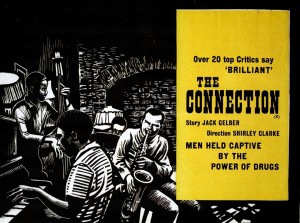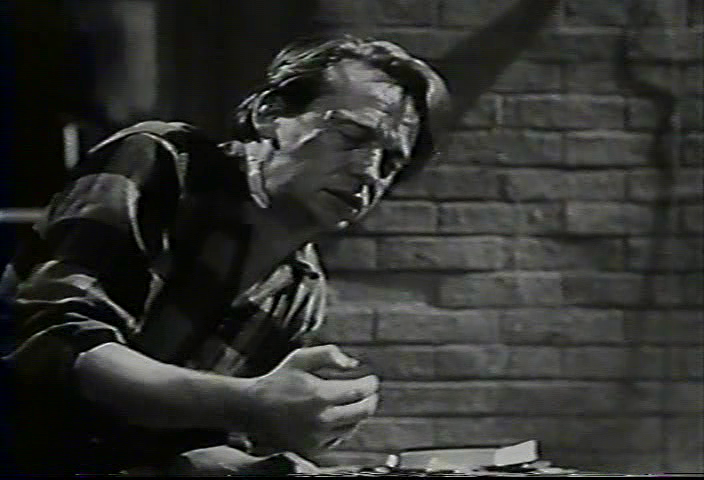“You will not see the man behind the man — because there is no such man!”
|

Synopsis:
A director (William Redfield) agrees to fund the next fix for a group of heroin junkies gathered in the apartment of a friend (Warren Finnerty) as they wait for the arrival of their “connection”, a drug supplier known as Cowboy (Carl Lee).
|
|
Genres, Themes, Actors, and Directors:
- Alcoholism and Drug Addiction
- Play Adaptations
- Shirley Clarke Films
Review:
Shirley Clarke’s black-and-white cinéma vérité film — crafted like a documentary, but actually highly scripted and based on a play by Jack Gelber — broke cinematic ground in its gritty depiction of heroin addiction, overtly flaunting New York’s censorship rules. Indeed, watching this independently produced film puts more mainstream movies of the same year in an interesting perspective: while many of these titles (i.e., To Kill a Mockingbird, The Manchurian Candidate, Days of Wine and Roses) were concerned with “social issues”, none were anything close to this raw in their depiction. With that said, The Connection unfortunately isn’t all that interesting or compelling; it’s far too stagy and dry, and I would revisit any of the above titles before this one for sheer entertainment value. Yet The Connection remains of minor interest simply for its historical importance.
Redeeming Qualities and Moments:
- A refreshingly frank (for the time in which it was made) look at drug use

Must See?
No, though it’s recommended for one-time viewing simply given its historical significance. Listed as a film with Historical Importance and a Personal Recommendation in the back of Peary’s book.
Links:
|
2 thoughts on “Connection, The (1962)”
First viewing. Not must-see.
I can’t speak about whatever controversy the film may have stirred up in its day (though the early ’60s were a particular time of risk-taking in theatrical experimentation) but if it had any real value, it would have stood the test of time. It’s pretentious to think this kind of presentation has insight just because it has a lot of blather in it. The result is a dull, pointless piece of crap. Even the reprieves with jazz selections don’t help.
The acting runs along lines of being terrible and in some cases embarrassing – not that the script affords much to work with.
Of course, the film does illustrate that addiction is boring…something we knew going in.
Side note: DP Arthur J. Ornitz would later shoot ‘The Boys in the Band’. This film has 8 junkies in a confined space and ‘TBITB’ has 8 gay guys in a confined space. There is some overlap in the visual style of both.
Once must for its place in independent film.
With that said – what was controversy in 1962 is less shocking in 2020. Also, while the film made it appear as if it was real footage, the closing credits set the record straight.
Even if Shirley Clarke tried to hide this one could easily tell be some of the amateur acting going on.
Still…it has its merits. The ensemble looked semi-authentic. The musicians added a semi-interesting aspect. And it was interesting seeing William Redfield (Harding in “One Flew Over the Cuckoos Nest” – his last role) playing the “director.”
A slice of independent film making at the time – partially successful, difficult to watch (mainly because it seemed long), but a film that is a part of history.